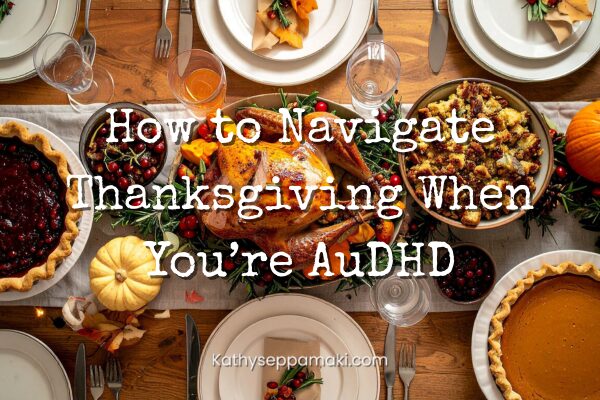Thanksgiving is supposed to be a day of gratitude, connection, and comfort food…yet for many of us with AuDHD, it can feel more like a sensory, social, and emotional obstacle course wrapped in pumpkin spice.
If you’re autistic, ADHD, or living at the intersection of both, holidays can be overwhelming in a very specific way. There’s the noise, the smells, the unspoken rules, the schedule changes, the pressure to mask, the chaos of “togetherness,” and the expectation to be on all day long. It’s a lot.
If you’ve ever ended Thanksgiving emotionally fried, overstimulated, or hiding in a bathroom just trying to breathe for two minutes…you’re not alone. I personally experience more meltdowns and shutdowns during big gatherings like Thanksgiving.
Here’s how to navigate the holiday in a way that supports your nervous system, honors your needs, and still allows space for joy and connection.
Start by managing expectations…yours and everyone else’s
People often go into Thanksgiving with nostalgic fantasies of what the day “should” look like. AuDHD brains don’t thrive on vague, high-pressure social scripts.
It’s okay to be realistic:
-
You might not enjoy the large-group chaos.
-
You may not want to be part of every conversation.
-
You might need breaks.
-
You may struggle with the unstructured downtime between dinner and dessert.
-
You might hit sensory overload faster than others.
If you’re hosting, communicate your boundaries in advance. If you’re attending, gently let people know what you need to feel comfortable. Sometimes, one sentence, such as “I may need a couple of breaks throughout the day so I don’t get overwhelmed”, can prevent misunderstandings later.
Create a sensory plan before you go
Thanksgiving environments are a sensory buffet… and not always the fun kind.
Think ahead about what you need:
-
Earplugs or noise-canceling headphones
-
Fidget toys or stim-safe items
-
Wearing comfortable clothes, not “holiday clothes” that make your skin crawl
-
Letting people know you won’t be hugging if that’s uncomfortable
-
Taking a walk before the gathering to regulate your body
-
Sitting at the end of the table, where you have more control over noise and movement
Your sensory needs are not “too much.” They are real, valid, and worthy of support.
Bring or request safe foods
AuDHD sensory sensitivities often extend to food textures, smells, and flavors. Holiday meals don’t always reflect our comfort foods, and that’s okay. My family does this for every family gathering, and it works well for us.
If you can:
-
Bring a dish you know you’ll eat.
-
Eat something safe before you go so you’re not starving.
-
Let your host know you need simple options without guilt or shame.
You don’t need to justify why sweet potato casserole feels suspicious or why turkey texture is hit-or-miss. You need food your nervous system won’t reject, and that’s reason enough.
Build in escape routes (yes, plural)
Having an exit plan isn’t rude, it’s self-care.
Escape routes might include:
-
Stepping outside for fresh air
-
Retreating to a quiet room
-
Going for a drive
-
A pre-planned “we’re leaving at X time” boundary
-
Having a friend you can text for quick grounding
AuDHD burnout can creep up fast. A five-minute escape can mean the difference between meltdown mode and actually enjoying dessert.
Give yourself permission to unmask
Masking all day is exhausting. And holidays often require even more social camouflage than usual.
If you feel safe, consider:
-
Stimming freely
-
Skipping eye contact when it feels uncomfortable
-
Sitting out of conversations that drain you
-
Allowing yourself to be quieter or more expressive than usual
-
Letting your face rest instead of forcing a social smile
Masking may help you survive some situations, but it shouldn’t be your only option.
Expect the dopamine rollercoaster
Thanksgiving involves long stretches of waiting…for food, for conversations to change, for people to finish telling the same stories they tell every year.
You may find yourself zoning out, restless, bored, or checking your phone a hundred times. That’s not rude. That’s your dopamine-starved brain seeking stimulation.
Bring things to keep your brain happy:
-
A book
-
A puzzle app
-
A knitting project
-
Scrolling a bit between social interactions
-
Helping in the kitchen (movement + purpose = dopamine relief)
Your nervous system will thank you.
Protect your energy before and after
A holiday is basically a marathon for an AuDHD nervous system. You need warm-up time and cool-down time.
Before Thanksgiving:
-
Get extra rest the night before
-
Do grounding or sensory regulation
-
Avoid overloading your schedule
After Thanksgiving:
-
Build in some recovery time
-
Don’t plan anything social the next day
-
Let yourself stim, decompress, or go nonverbal
-
Be gentle with yourself emotionally
You don’t “bounce back” like neurotypical people, and that’s okay.
Replace holiday “shoulds” with what actually works for you
You don’t need to participate in traditions that drain you. You don’t need to hug relatives. You don’t need to stay at the table long after you’re done eating. You don’t need to attend multiple gatherings in one day.
You’re allowed to create new rituals:
-
A quiet Thanksgiving morning walk
-
A gratitude practice that doesn’t feel forced
-
Watching movies instead of attending big gatherings
-
Cooking a simple meal for your immediate household
-
Spending the day alone if that’s what nourishes you
It’s safe to create your own way of celebrating Thanksgiving!
Your version of Thanksgiving is valid, even if it looks nothing like the Hallmark version.
Thanksgiving as an AuDHD adult can be overwhelming, but it doesn’t have to be unbearable. When you support your nervous system, set boundaries, plan for sensory needs, and let go of unrealistic expectations, the holiday becomes far more manageable—and even enjoyable.
You deserve a Thanksgiving that feels safe, spacious, and aligned with who you are. Most of all, you deserve peace in your own body while the world around you buzzes with holiday chaos.
And if all else fails? Take your pie to-go and enjoy it in bed. There are no wrong answers here.




